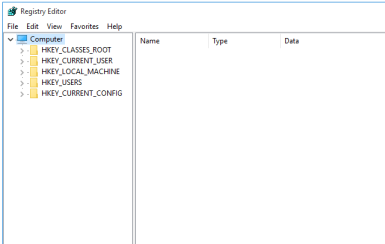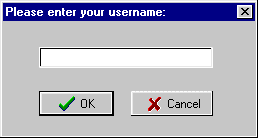Working with Windows Registry in Delphi
How to Read or Write data in Windows Registry by using Delphi ?
What is Windows Registry? a small introduction.
Registry is a simple hierarchical database that can be used to store Application or User related data in Tree structure. Windows Operating System already uses Registry to store different settings and User related data. It stores data in Root, Key and Value pattern.
Root - There are seven predefined root keys, traditionally named according to their constant handles defined in the Win32 API, or by synonymous abbreviations (depending on applications):• HKEY_LOCAL_MACHINE
• HKEY_CLASSES_ROOT
• HKEY_CURRENT_USER
• HKEY_USERS
Key – Variable name
Value – Variable value
The Registry "database" is stored as a binary file. To find it, run regedit.exe (Windows registry editor utility) in your Windows directory.
For more about Windows Registry please visit following link…
https://support.microsoft.com/en-us/kb/256986How to access Windows Registry from Delphi?
In Delphi we generally access Windows Registry to store Application and User related data like storing form position, User settings etc. Delphi provides TRegistry or TRegistryIniFile class that can be used to read/write Registry data.
TRegistry - TRegistry class provides generic encapsulation of Registry API to read/write data in Window Registry.
TRegistryIniFile - TRegistryInifile provides interface of the TInifile class to read/write data in Windows Registry. In case to make portability our Application with INI based and Registry based version we use TRegistryIniFile.TRegIniFile - Same as like TRegistryIniFile. This only acts as helper class of TRegistryIniFile class.
For more about Delphi class helper visit...
http://docwiki.embarcadero.com/RADStudio/XE8/en/Class_and_Record_Helpers_(Delphi)
Using TRegistry
The reading of data from the registry is illustrated with an example. We will create a new form which will remember its previous location on the screen. The location is determined by the Top and Left properties of the form. In addition to these, we will read and store the Height and Width properties of the form
const
cKey = 'SOFTWARE\Test_Company\Test_Application';
// key where item values will be stored and read
procedure TRememberForm.FormCreate(Sender:
TObject);
var
lReg: TRegistry;
getInt: integer;
begin
inherited;
// general purpose:
// read latest Left, Top, Width and Height
lReg := TRegistry.Create;
// create registry object
lReg.RootKey := HKEY_CURRENT_USER;
// set root to current user root,
// to ensure different users on this
// machine have their own setting
lReg.OpenKey(cKey, True);
// Open key where we will read items
if lReg.ValueExists(self.name +
'.Left') then // check if
value for item formname.left exists
begin
getint := lReg.ReadInteger(self.name
+ '.Left'); // Read left position of actual form
if getint > 0 then
self.Left := getint;
end;
if lReg.ValueExists(self.name +
'.Top') then
begin
getint := lReg.ReadInteger(self.name + '.Top');
if getint > 0 then
self.Top := getint;
end;
if lReg.ValueExists(self.name + '.Width') then
begin
getint := lReg.ReadInteger(self.name + '.Width');
if getint > 0 then
self.Width := getint;
end;
if lReg.ValueExists(self.name + '.Height') then
begin
getint := lReg.ReadInteger(self.name + '.Height');
if getint > 0 then
self.Height := getint;
end;
// Close and free
lReg.CloseKey;
lReg.Free;
end;
The FormDestroy event is a good moment to write the data to the registry. The code is a lot shorter:
procedure TRememberForm.FormDestroy(Sender: TObject);
var
lReg: TRegistry;
begin
// open registry, set root and key
lReg := TRegistry.Create;
lReg.RootKey := HKEY_CURRENT_USER;
lReg.OpenKey(cKey, True);
// write last Left, Top, Width and Height
lReg.WriteInteger(self.name + '.Left', self.Left);
lReg.WriteInteger(self.name + '.Top', self.Top);
lReg.WriteInteger(self.name + '.Width', self.Width);
lReg.WriteInteger(self.name + '.Height', self.Height);
// close all
lReg.CloseKey;
lReg.Free;
inherited;
end;
As with reading data, the same applies with writing data. You can easily write boolean, datetimes, floats, strings and binary data.
If an Application runs under 32 bit OS then it works fine but if runs on 64bit only the 32bit apps are recorded because of the Wow6432 node redirection. So in this case we have to create TRegistry object like follow..
//to access 64bit OS registry data create Tregistry object as follow//
Registry := TRegistry.Create(KEY_WRITE OR KEY_WOW64_64KEY);
Using TRegistryIniFile
Read form data from Registry on load
procedure TForm1.FormCreate(Sender: TObject);
var Reg: TRegistryIniFile;
begin
Reg := TRegistryIniFile.Create('Software\' + Application.Title');
try
Top := Reg.ReadInteger(Name, 'Top', Top );
Left := Reg.ReadInteger(Name, 'Left', Left );
Width := Reg.ReadInteger(Name, 'Width', Width );
Height := Reg.ReadInteger(Name, 'Height', Height );
Caption := Reg.ReadString (Name, 'Caption', Caption);
finally
Reg.Free;
end;
end;
Write form data to Registry on destroy
procedure TForm1.FormDestroy(Sender: TObject);
var Reg: TRegistryIniFile;
begin
Reg := TRegistryIniFile.Create('Software\' + Application.Title');
try
Reg.WriteInteger (Name, 'Top', Top);
Reg.WriteInteger (Name, 'Left', Left);
Reg.WriteInteger (Name, 'Width', Width);
Reg.WriteInteger (Name, 'Height', Height);
Reg.WriteString (Name, 'Caption', Caption);
finally
Reg.Free;
end;
inherited;
end;
Limitations and points need to care when using registry to store data.
There are a few limitations which we haven't discussed. First, The registry is not meant a database for storing vast quantities of data. It is meant for storing initialization and configuration data. Anything over 2Kb had better be stored in a separate file. If you wish, you can mention the corresponding file location in the registry. Then WriteBinary is especially useful for storing recordtypes. Using a record type saves you typing code, and it can be written to and read from the registry with 1 statement, saving both time and storage. And a large registry might slow down all applications.

Comments
Post a Comment